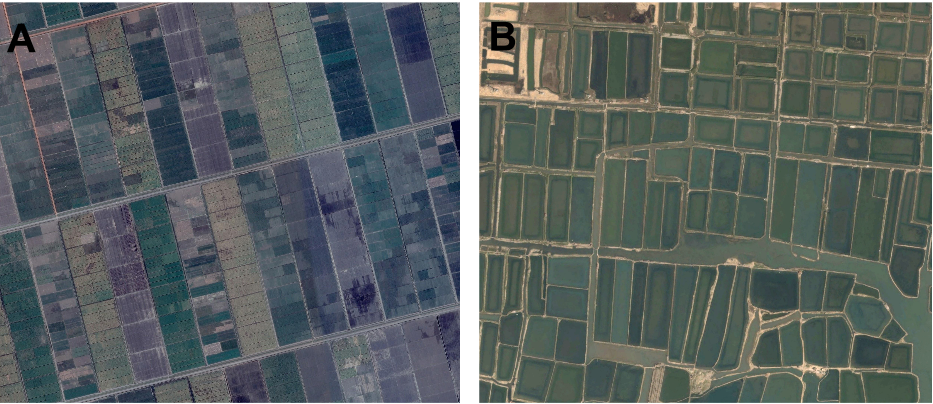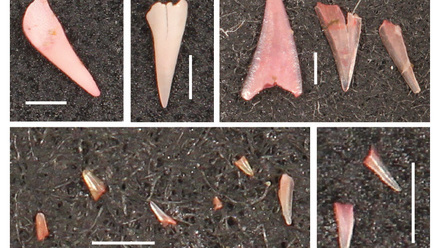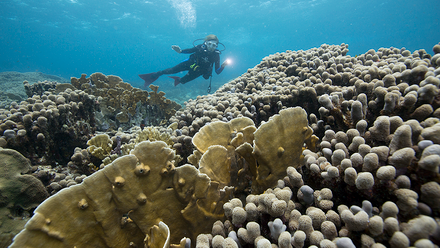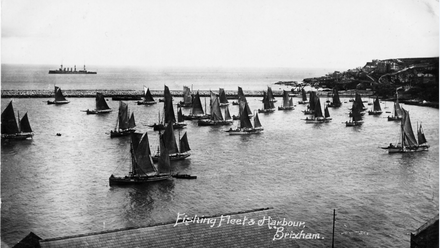Two views on a revolution in aquaculture
Banner image: A school of Atlantic bluefin tuna in a transport cage in the Mediterranean. Image: Roger Grace/Greenpeace.
1: The case for ocean farming
"We must plant the sea and herd its animals ... That is what civilization is all about—farming replacing hunting." Jacques Yves Cousteau
By Benjamin S. Halpern and Halley E. Froehlich.
The human population is expected to grow to almost 10 billion people in the next 50 years. How are we going to feed all of those people, and do so sustainably? Aquaculture is not only necessary as part of the solution; it is likely the best way to meet this demand.
Already, food from fish has overtaken beef, and aquaculture (from the sea and land) has surpassed capture fisheries for the first time in history. In fact, the Food and Agriculture Organization (FAO) of the United Nations estimates aquaculture will increase production by 39per cent over the next decade—producing a whopping 102 million tonnes—while capture fisheries’ outputs are projected to remain relatively unchanged. A large proportion (~40per cent) of the aquaculture growth will likely occur as ‘ocean farming’ or ‘mariculture.’ Most of it can occur completely out of sight, either with submersible technology (Fig 1) and/or offshore, hidden beneath the horizon.

Figure 1. Amberjack (or Seriola) farm offshore of Kona, Hawaii, USA. The cone-shaped net is the top of one of four submersible cages that has been raised for service. When all four cages are down only small floats are visible. Image: Michael Rust.
These statistics are telling, yet critiques of aquaculture have been many and loud: mangrove habitat destruction, pollution, disease, genetic escapes, and depletion of wild fish for feed—many people equate farmed fish with the worst of human endeavours. So, is the growth in mariculture going to be a good thing or a bad thing for the planet and for humanity? There are three ways to frame this question: mariculture versus all protein-based food systems, mariculture versus conservation, and mariculture versus wild-caught fisheries.
Beyond global vegetarianism, the strongest case for mariculture comes when comparing it to all other protein food systems (e.g., beef, pork, chicken), even freshwater aquaculture. In fact, this is the fairest comparison to make as it puts everything on the same table for judgment. Efficiencies of converting feed to protein, per-kilogram of environmental impact, and health benefits are unmatched (Fig 2). This means a very high amount of protein can be produced with very little area, and thus reduced environmental impact. Even better, bivalve production is the only protein-based food system that is not only carbon-neutral but in fact a carbon sink. And with 200+ farmed marine species (Fig 3), we can diversify production and avoid the pitfalls of monoculture that plague the agricultural industry.
Mariculture can also be harnessed as a conservation tool—in fact it already is! Hatcheries are part of the aquatic farming domain, and without hatcheries salmon species would be a thing of the past in most regions of the world. Humans try to protect important terrestrial animals like the panda through captive breeding, and the same logic can be, and is being applied in the aquatic realm through aquaculture. In many cases, restoration is a form of mariculture.

Figure 2. Left panel depicts feed conversion ratios (FCR) for the primary sources of animal protein. FCR represent the amount of animal feed needed (lb) for one pound of body mass. Right panel shows the current status of fish stocks as estimated by FAO (2016). Image: H.E. Froehlich.
Ultimately, most people simply want to compare fish to fish. How does mariculture stack up against wild fisheries? As a means to feed the planet and to reduce environmental impact, mariculture, in particular offshore mariculture, has the potential to outperform wild-caught fisheries. Globally, capture fisheries have stalled or declined, and there is a limit to the number of fish we can harvest (sustainably or otherwise) from the wild (Fig 2). Furthermore, overfishing, illegal fishing, bycatch, habitat destruction, and human-induced climate change have contributed to the deplorable state of many fisheries. While improved management can move towards sustainability (for example, in many US fisheries), the majority of the world’s fisheries do not have the resources, interest, and/or incentive to reform. In contrast, offshore mariculture has essentially no limits to how much seafood can be produced, and most of the environmental risks are more easily mitigated —particularly pollution and disease.
Aquaculture has not yet eased the pressures on wild fish populations, but the majority of seafood did not come from aquaculture until now. A paradigm shift is occurring as more people and governments start to see the potential of ocean farming as a sustainable food source and viable livelihood option. Our colleges, McCauley et al., point to the ecological cost of wild-based feeds, however this use is declining and alternative feed sources like Omega-3 algae—which launched commercially this year—insects, bacteria, and yeast can replace wild-caught meal and oil. Some mariculture does not even need to be fed; bivalves provide food and ecosystem services by filtering and cleaning the water for us. Entire mini-ecosystems can even be created where fish, seaweed, and bivalves grow, thrive, and are farmed together.

Figure 3. Left panel shows a fish auction in Miyako, Iwate prefecture, Japan and the right panel a fish market display in San Sebastian, Spain exhibiting the diversity of consumed marine species. Image: Michael Rust.
Fishing is the last of our commercial hunting practices. Imagine trying to feed the world on feral pigs and wild cows. Then why, particularly in the developed nations, are we still fishing out the oceans when we could be sustainably practising and perfecting ocean farming? Mariculture could provide better feasibility of monitoring and managing for the lowest possible impact on the environment and more control over the quality of conditions the fish are raised in.
Aquaculture is growing with or without the scientific community and public input, and its importance and application in fisheries science has been largely overlooked—until now. Aquaculture does not have to be ubiquitous, nor does it need to replace all wild-caught fisheries. However, it must be a major global priority for marine science, conservation, food provision and management in an ever-changing world.
Benjamin S. Halpern (halpern@bren.ucsb.edu)1,2,3 and Halley E. Froehlich (froehlich@nceas.ucsb.edu)1
1. National Center for Ecological Analysis and Synthesis, University of California, 735 State St., Suite 300, Santa Barbara, CA 93101, USA
2. Bren School of Environmental Science and Management, University of California, Santa Barbara, Santa Barbara, CA 93106, USA
3. Imperial College London, Silwood Park Campus, Buckhurst Rd., Ascot SL5 7PY, UK
2. Ploughing under the ocean?
"In Wildness is the preservation of the world." Henry David Thoreau
By Douglas McCauley, Erin Dillon, Francis Joyce and Ashley Stroud.
2014 was the first year ever in which our planet ate more fish raised on farms than fish caught in the wild. This is a turning point of great significance. This shift promises to be as transformative as when we switched on land from hunting and gathering food from the wild to farming domesticated plants and animals.
Flying over parts of the Midwest of the United States reveals a scene of circles and squares that resemble a Mondrian painting (Fig. 4a). It is easy to forget that this carefully sculpted geometric world of corn, wheat, and sorghum, only 150 years ago, was the Great Plains ecosystem: a hyperdiverse grassland traversed annually by 60 million migrating bison. Large communities of indigenous people and native predators fed off this wild bounty before exponential human growth in the Americas necessitated the appropriation of this ecosystem for agriculture.
Mariculture (ocean aquaculture) has grown 1570per cent in the last 4 decades and growth is projected to continue. As scenes of mariculture reminiscent of flyover views of the domesticated Great Plains begin to appear in the oceans (Fig 4b), it is worth reflecting on what this explosive growth will mean for the ocean’s future.

Figure 4. Left (a) Intensive agriculture (US Midwest), and Right (b) Intensive mariculture.
Early reviews of ocean farming highlighted some of the collateral damage caused by dirty aquaculture. Perhaps unsurprisingly, problems arising from poorly managed fish pens parallel those of ungulate feedlots: excessive pollution from effluent, genetic pollution and ecological damage from aquaculture escapees, disease, and habitat destruction.
Innovation in aquaculture has helped mute some of these problems. New mariculture tech, for example, has allowed fish farms to move farther offshore where higher rates of water flow help dilute pollution and moderate disease. It will be hard, however, to resolve some of the core trade-offs between a farmed and wild future for the oceans. An intelligently administered cattle ranch in the Amazon still fundamentally displaces forest just as a well-run shrimp farm in Myanmar still displaces mangroves—a critical nursery habitat for wild fish. Other zero-sum trade-offs abound. For instance, some of the most popular and profitable species being farmed in the oceans today are essentially underwater lions and tigers: salmon, jacks, cobia, and tuna. Farm raising predators is ecologically costly and requires large inputs of forage fish that might otherwise feed wild fish.
The privilege of harvesting wild foods from healthy ecosystems is one that we have largely forgotten on land and that we all too often take for granted in the oceans. Consider the case of Los Angeles (LA). Hunting and gathering in inner city LA is obviously not an option. But the long established poor, indigenous, and diasporic communities of the city actively go to public piers, beaches, and breakwalls to catch wild, free food from the ocean. Much of the wildness now extinct on the Great Plains still thrives below these high tide lines, feeding the hunger and imagination of coastal populations.
Human populations are expected to grow by up to 50 per cent by the end of the century. Our colleagues Halpern and Froehlich very accurately point out that this growth, coupled with increasing wealth and subsequent spikes in demand for protein, will stress our global food production system. We question, however, whether these growth projections give us carte blanche to aggressively advance an agenda for ocean farming. This is particularly so when many already modified terrestrial systems are operating below their productive capacities, and changes in food consumption patterns (e.g. eating lower in food chains) offer pathways to help reduce food shortfalls.
The oceans today operate as one gigantic free-range organic farm. One that we don’t need to water, fertilize, till, weed, or medicate. It takes care of itself and we harvest from it.
Yields from a wild ocean will never be as high as farmed ocean—because ocean ecosystems did not exist to generate ape food. Nevertheless, we generate millions of tons of highly nutritious wild seafood annually from the oceans. A century of experiments and mistakes in the management of wild fisheries have helped us identify strategies that can vastly increase these yields, if properly implemented.
In an increasingly crowded and hungry world it is legitimate to carefully explore new pathways to feeding ourselves from the ocean. However, overzealously and thoughtlessly marching forward this revolution in mariculture is likely to present major challenges to the future wildness of our oceans: the last of our planet’s great ecosystems in which we get to have our biodiversity and eat it too.
Douglas McCauley (dmccauley@ucsb.edu), Erin Dillon (erin.dillon@lifesci.ucsb.edu), Francis Joyce (francis.joyce@ucsb.edu) and Ashley Stroud.
Marine Science Institute and the Department of Ecology, Evolution, and Marine Biology, University of California, Santa Barbara, CA 93106, USA
Further reading:
Costello, C., D. Ovando, T. Clavelle, C. K. Strauss, R. Hilborn, M. C. Melnychuk, T. A. Branch, S. D. Gaines, C. S. Szuwalski, R. B. Cabral, D. N. Rader, and A. Leland. 2016. Global fishery prospects under contrasting management regimes. Proceedings of the National Academy of Sciences 113: 5125–5129.
FAO. 2016. The State of World Fisheries and Aquaculture 2016. Contributing to food security and nutrition for all. Rome. 200 pp.
Henry, M., L. Gasco, G. Piccolo, and E. Fountoulaki (2015) Review on the use of insects in the diet of farmed fish: Past and future. Animal Feed Science and Technology 203, 1–22. doi:10.1016/j.anifeedsci.2015.03.001.
Naylor, R. L., R. J. Goldburg, J. H. Primavera, N. Kautsky, M. C. M. Beveridge, J. Clay, C. Folke, J. Lubchenco, H. Mooney, and M. Troell. 2000. Effect of aquaculture on world fish supplies. Nature 405: 1017–1024.
Sarker, P.K., A.R. Kapuscinski, A.J. Lanois, E.D. Livesey, K.P. Bernhard, and M.L. Coley (2016) Towards sustainable aquafeeds: Complete substitution of fish oil with marine microalga Schizochytrium sp. improves growth and fatty acid deposition in juvenile Nile tilapia (Oreochromis niloticus). PLoS ONE 11, 6 e0156684. doi:10.1371/journal.pone.0156684.
Tilman, D. and M. Clark (2014) Global diets links environmental sustainability and human health. Nature 515, 518–22. doi:10.1038/nature13959.






